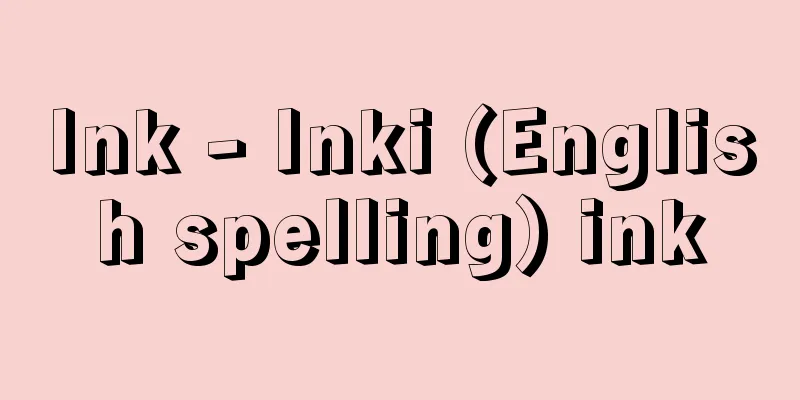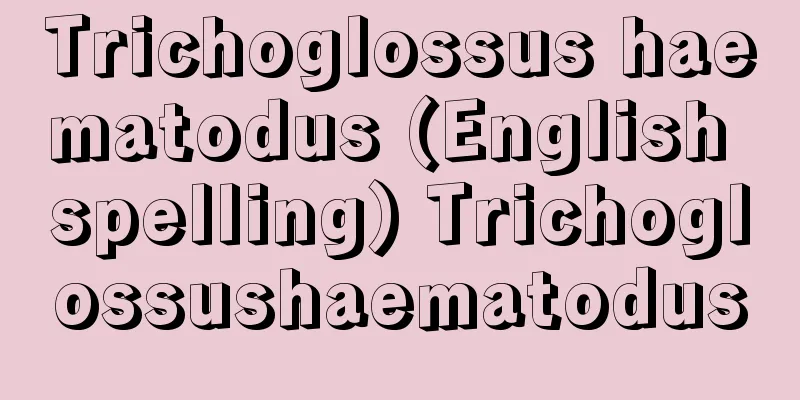Ink - Inki (English spelling) ink

|
A liquid used for writing or printing. Also called ink. There are water-soluble and oil-soluble types. The word ink comes from the Latin word encaustum, which means "burned onto a plate." [Matsuo Nozawa] historyIt is said that humans began to use ink to write characters around the end of the 4th millennium BC. In Egypt at that time, they used ink made by mixing resin or glue with charcoal and soot. The main ingredient of the ink used by the Egyptians was carbon, and they would drip the ink onto an inkstone called a slab by smoking animal bones and horns, or burning oily pine wood, then mixing it with glue and oil and rubbing it with a smoothing stone called a muller to make ink. In China, people wrote characters on a brush-shaped bamboo soaked in lacquer. It is said that Chinese ink was invented by Tian Zhen, but this is not certain. It is similar to modern ink, made by smoking lacquer or pine resin to extract carbon, and adding glue to it to harden it. The ancient Romans used sepia, a black pigment secreted by squids. Other inks included red ink made with vermilion (mercury sulfide), ink made from red clay called rubrica, purple ink made from dried and crushed murex conch shells, and green ink made from verdigris and vinegar. Around the 2nd century BCE, the Greek mechanical engineer Philo discovered that if he wrote characters with aconite liquid and then moistened the surface with a liquid containing iron after it dried, the characters would turn black. This was the beginning of iron gall ink, which was widely used in medieval Europe, and the principle is the same as that of later blue-black ink. Aconite gall is a nodule-like substance that forms when a type of aphid parasitizes a plant called sumac, and contains a lot of tannic acid. Since the 18th century, advances and developments in chemistry have led to improvements in color and quality, which have continued to the present day. [Matsuo Nozawa] kindsCurrent inks can be broadly divided into three types: writing ink, marking ink, and printing ink. Writing inks are either water-soluble or oil-soluble. Water-soluble inks are used in fountain pens and felt-tip pens. They are intended for writing on paper and are colorful but weak against water. On the other hand, oil-soluble inks are used in ballpoint pens and felt-tip pens and have excellent water resistance. In particular, oil-soluble inks for felt-tip pens can be used to write on impermeable surfaces other than paper. Writing inks can be divided into dye inks, pigment inks, and mixed inks, which are intermediate types, depending on the pigment used. Dye inks are made by dissolving dyes in water, and are characterized by a rich and vivid color and no precipitation, but are weak against water and lack durability. Pigment inks are inks in which fine particles of water-insoluble pigments (such as carbon) are dispersed in water, and examples of these include India ink, stock inks, and drafting inks. They are not suitable for fountain pens, but are used for brushes, steel pens, and drawing tools. Mixed inks are a combination of dyes, organic lakes, and pigments, and include blue-black inks, tannic acid dye inks, and black fountain pen inks. Blue-black inks apply the principle that the ferrous tannate contained in the ink is oxidized when it comes into contact with oxygen in the air, turning it into ferric tannate, which turns black. Ferrous tannate is colorless and transparent unless it changes to ferric tannate, so blue-black ink has a blue dye in the solution. When written, the ink is blue, but as the ferrous tannate changes to ferric tannate, the ink becomes more water-resistant and light-resistant. Fountain pen black ink (real black) is made for fountain pens by combining carbon black and a black dye. Symbol inks used on instruments and stamps are made by adding moisture-absorbing substances such as glycerin or glycol to dye inks and pigment inks. This gives them a stronger viscosity than regular writing inks, allowing them to adhere evenly to the surface of rubber stamps and make impressions on paper. As better dyes than water-insoluble pigments become available for writing and symbol inks, the proportion of dye inks that can fully utilize the ink's performance is increasing. [Matsuo Nozawa] [Reference] | |Source: Shogakukan Encyclopedia Nipponica About Encyclopedia Nipponica Information | Legend |
|
文字を書写したり印刷する場合に用いる液体。インクともいう。水溶性と油溶性がある。インキの語源はラテン語のエンカウスツームencaustumで、これは「焼板に焼き付ける」という意味である。 [野沢松男] 歴史人間がインキを用いて文字を記したのは、紀元前4000年代の終わりごろからといわれ、当時エジプトでは、樹脂や膠(にかわ)に木炭や煤煙(ばいえん)を混ぜてつくったインキを用いていた。エジプト人が用いたインキの主成分はカーボン(炭素)で、動物の骨や角(つの)などをいぶし焼きにしたり、脂(やに)の多い松の木などを燃やしたものをスラブslabという硯(すずり)に滴下し、さらに膠や油を混ぜて、ミュラーmullerというならし石で擦り合わせてインキにした。また中国では筆状の竹に漆を含ませて、文字を書いていた。中国の墨は田真(でんしん)が発明したというが、さだかではない。漆や松脂をいぶし焼きにして炭素をとり、それに膠を加えて固めた現在の墨と同様のものである。古代ローマ人は、セピアsepiaというイカの分泌する黒色色素を用いていた。そのほか銀朱(硫化水銀)を使った赤インキ、ラブリカrubricaという赤土でつくったインキ、ミュレックスmurexというホラガイを陰干しにし、それをつぶしてつくった紫インキ、緑青と酢でつくった緑色インキなどがあった。 前2世紀ごろ、ギリシアの機械技師フィーロが、五倍子(ごばいし)(附子(ぶし))の液で文字を書き、乾いたあとに鉄分を含む薬液で表面を潤すと、文字が黒色に変化するのを発見した。これが中世ヨーロッパで広く使われた五倍子鉄インキのはしりで、後のブルーブラック・インキと原理が変わらない。五倍子は、ヌルデという植物にアブラムシの一種が寄生してできるこぶ状のもので、タンニン酸を多く含んでいる。18世紀以後は、化学の進歩と発展により色や質が改良され、現在に至っている。 [野沢松男] 種類現在のインキを大別すると、筆記用インキ、記号用インキ、印刷用インキの3種となる。筆記用インキには水溶性と油溶性があり、水溶性インキは万年筆やサインペンなどに用いられている。紙に書くのが目的で、色鮮やかだが水に対して弱い。一方油溶性インキは、ボールペン、フェルトペンなどに用いられ、耐水性に優れている。ことにフェルトペン用の油溶性インキは、紙以外の不浸透面にも書くことができる。 また筆記用インキは、用いる色素により、染料インキと顔料インキ、さらにその中間の混合型インキとに分けられる。染料インキは染料を水に溶かしたもので、色が豊富で鮮明、沈殿をおこさないなどの特徴があるが、水に弱く耐久性に欠ける。顔料インキは、水に溶けない色素(カーボンなど)の微粒子を水に分散させたインキで、墨汁や証券用インキ、製図用インキがそれである。万年筆には適さず、筆や鋼ペン、烏(からす)口(製図用具)などに用いる。混合型インキは、染料と有機レーキ、顔料を組み合わせたもので、ブルーブラック・インキ、タンニン酸染料インキ、万年筆用黒インキなどが該当する。ブルーブラック・インキは、インキに含まれているタンニン酸第一鉄が空気中の酸素に触れて酸化し、タンニン酸第二鉄に変化して黒色となる原理を応用したものである。タンニン酸第一鉄は、第二鉄に変化しないと無色透明なので、ブルーブラック・インキはその溶液の中に青色染料を入れてある。書いた当初は青色であるが、タンニン酸第一鉄が第二鉄に変わることにより耐水性、耐光性が強められる。万年筆用黒インキ(リアルブラック)は、カーボンブラックと黒色染料を併用して万年筆用にしたものである。 計器やスタンプ類に用いられる記号用インキは、染料インキおよび顔料インキに、グリセリンやグリコールなどの吸湿物を加えてつくる。それによって一般の筆記用インキより粘度を強くし、ゴム印の印面にむらなく付着して紙に捺印(なついん)できるようにしてある。なお、筆記用および記号用インキは、水に溶けない顔料よりも良質の染料ができるのにしたがって、インキ性能が十分に生かせる染料インキの割合が増加してきている。 [野沢松男] [参照項目] | |出典 小学館 日本大百科全書(ニッポニカ)日本大百科全書(ニッポニカ)について 情報 | 凡例 |
Recommend
Stylel
…The pharynx of rotifers and the stomach of crust...
Honourable Company of Edinburgh Golfers
… In the 18th century, aristocrats who enjoyed go...
Kirikamuro
...A large piece of Satsuma-mono. It is a reworki...
Dengaku of Tamine - Dengaku of Tamine
A folk performing art. This dengaku is held at the...
Ukyo Chodai - Ukyo Chodai
...The only historical example is when Omi Shugo ...
Nagatoshi Yamanaka
Year of death: December 24, 1608 (February 10, 160...
Forbidden principle
⇒Pauli's principle Source: About Shogakukan Di...
Carving fork
A large two-pronged fork used to cut meat dishes a...
Comet Halley
Also known as Halley's Comet. I. Newton publis...
Yaroumushi - Yaroumushi
Actor Review Record (Yaro Hyoban-ki). Author unkno...
Tales of Temper - Tales of Habits
Also known as "Kanpekidan," this novel d...
Rosa banksiae (English spelling) Rosabanksiae
…[Naruhashi Naohiro]. . … *Some of the terms ment...
Norwegian - Norwegian
The official language of the Kingdom of Norway. I...
Uchiyama Shoin Paper
…After the war, this stopped with the advancement...
Forbidden rope
...The inside is usually considered a pure area, ...









